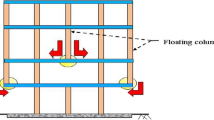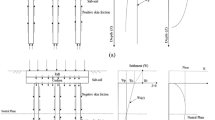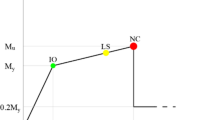Abstract
This paper presents some of the geotechnical studies carried out for the seismic design of the one-span suspension bridge across the Messina Strait, that is to connect Sicily with mainland Italy. These studies included advanced geotechnical characterisation, through in situ and laboratory tests, estimate of site stability involving both liquefaction analysis and submerged slope stability, evaluation of soil-foundation stiffness for spectral analysis of the superstructure, 3D FE static calculations, evaluation of anchor block performance under seismic conditions, and full dynamic analyses of the soil–structure interaction. The paper summarises the main results obtained from the geotechnical characterisation of the foundation soils, reports the approach adopted for evaluating the seismic performance of the anchor blocks through a modified Newmark-type calculation, and presents the study of the soil–structure interaction carried out through a series of two-dimensional, plane strain numerical analyses. In these analyses, in addition to the embedded foundation elements, the models included a simplified structural description of the bridge towers specifically designed to reproduce their first vibrations modes, that were deemed to have the most significant influence on the system’s dynamic response. The illustration is limited to the foundation systems of the bridge located on the Sicily shore.


















Similar content being viewed by others
References
Baldi G, Bellotti R, Ghionna V, Jamiolkowski M, Pasqualini E (1985) Penetration resistance and liquefaction of sands. In: Proceedings of XI international conference on soil mechanics and foundation engineering. ICSMFE San Francisco, vol 4, pp 1891–1896
Bolton MD (1986) The strength and dilatancy of sands. Géotechnique 36(1):65–78
Callisto L, Rampello S, Viggiani G (2013) Soil structure interaction for the seismic design of the Messina Strait Bridge. Soil Dyn Earthq Eng 52:103–115
Cubrinovski M, Ishihara K (1999) Empirical correction between SPT-N value and relative density for sandy soils. Soils Found 39(5):61–71
Fioravante V, Giretti D, Jamiolkowski M, Rocchi GF (2012) Triaxial tests on undisturbed gravelly soils from the Sicilian shore of the Messina Strait. Bull Earthq Eng. doi:10.1007/S10518-012-9374-7. Published online 21 Sept 2012
Foti S, Lai CG, Lancellotta R (2002) Porosity of fluid saturated porous media from measured seismic wave velocities. Géotechnique 52(5):359–373
Itasca (2005) FLAC: fast Lagrangian analysis of continua. v. 5.0 user’s manual. ITASCA, USA
Jamiolkowski M, Lo Presti D (2002) Geotechnical characterisation of Holocene and Pleistocene Messina sand and gravel deposits. In: Proceedings of the international symposium on characterisation and engineering properties of natural soils, Singapore, Swets and Zeitlinger, pp 1087–1119
Joyner WB, Chen ATF (1975) Calculation of nonlinear ground response in earthquakes. Bull Seismol Soc Am 65(5):1315–1336
Lancellotta R (2007) Lower-bound approach for seismic passive earth resistance. Géotechnique 57(3):319–321
Masing G (1926) Eigenspannungen und Verfertigung bim Messing. In: Proceedings of the 2nd International Congress on Applied Mechanics, Zurich
Newmark NM (1965) Effects of earthquakes on dams and embankments. Géotechnique 15(2):139–160
Schanz T, Vermeer PA, Bonnier PG (1999) Formulation and verification of the hardening—soil model. In: Proceeings of the Plaxis symposium on beyond 2000 in computational geotechnics, Amsterdam, pp 281–296
Schnabel PB, Lysmer J, Seed HB (1972) SHAKE, a computer program for earthquake response analysis of horizontally layered sites. Report: Earthquake Engineering research Center, University of California, Berkeley
Seed HB, Idriss IM (1970) Soil moduli and damping factors for dynamic analysis. Report no. EERC 70–10, University of California, Berkeley
Tanaka Y, Kudo Y, Yoshida Y, Ikemi M (1987) A study on the mechanical properties of sandy gravel—dynamic properties of reconstituted samples. Central Research Institute of Electric Power Industry. Report U87019
Acknowledgments
The Authors wish to acknowledge Prof. Michele Jamiolkowski for the fruitful and stimulating discussions along the development of the study; they are also indebted Dr. Luca Masini and Dr. Riccardo Conti for performing some of the numerical analyses.
Author information
Authors and Affiliations
Corresponding author
Rights and permissions
About this article
Cite this article
Rampello, S., Callisto, L. & Viggiani, G. Predicting the seismic behaviour of the foundations of the Messina Strait Bridge. Bull Earthquake Eng 12, 1201–1219 (2014). https://doi.org/10.1007/s10518-013-9536-2
Received:
Accepted:
Published:
Issue Date:
DOI: https://doi.org/10.1007/s10518-013-9536-2




